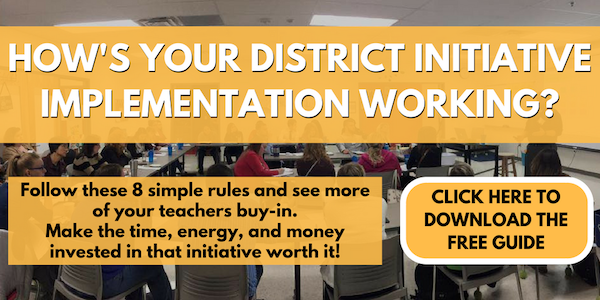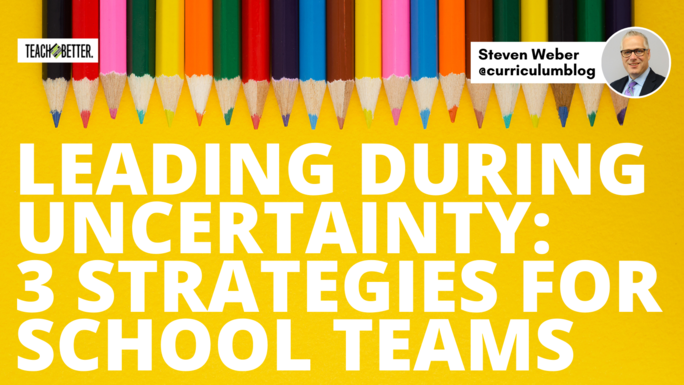TL;DR:
- Leading during complexity and uncertainty is becoming a norm for those in education.
- Skinny plans, reflection stems, and scenario planning are three proven strategies for school teams during uncertain times.
During a crisis, you discover your own strengths and weaknesses as a leader. Leading during the COVID-19 crisis has been an unprecedented challenge for teachers, administrators, and superintendents. Traditional unit plans were converted to hybrid lessons and in some cases, teachers were required to teach students onsite, virtually, and in hybrid settings simultaneously. Leaders have emerged at every level, from the front office staff to counselors and classroom teachers.
As schools begin to plan for the 2021-22 school year, there remains uncertainty about the reopening of schools for onsite instruction.
School schedules and learning options are still being developed in most states. It is uncertain whether students will be prepared for the next grade level based on attendance, connectivity, student engagement, and the trauma that all students have experienced during the twelve months that COVID-19 has disrupted teaching and learning.
According to Hefferman (2020, p. xii), “We have moved from a complicated world to a complex one. The two aren’t the same.” In order to survive and thrive in a complex world, educators will need to use non-traditional approaches to planning. The September unit for first graders may be unpredictable at this point.
The ability to have student assemblies and educational programs for the entire school may not be possible until the number of people who have tested positive significantly decreases. While complexity can be extremely frustrating, it is important to note that a group of educators who plan multiple scenarios for back-to-school can provide a strong foundation for future decisions.
The time spent planning will provide teams with an opportunity to reflect on this unprecedented school year, while creating plans for the future. Click To TweetHow can educators support the wide range of student needs in the midst of complexity and uncertainty?
“Being effective in today’s world is less a question of optimizing for a known (and relatively stable) set of variables than responsiveness to a constantly shifting environment” (McChrystal, Collins, Silverman, and Fussell, 2015, p. 20). If educators create a single plan and put all of their proverbial ‘eggs in the same basket’ they will become disheartened and their plan may not be relevant by August.
Strategies for School Teams: Skinny Plans
Too often, educators attempt to create 45-page documents which detail every step that should be considered by school teams. A 45-page plan works well during certainty and predictable times, but is irrelevant during complexity and uncertain times. Kirtman and Fullan (2016, p. 24) provide the following guidelines for the development of skinny plans.
Skinny plans include:
- A clear vision, mission, context, or description of what problem needs to be solved.
- High-level strategies and initiatives for major impact on student achievement.
- Reference to other plans that might be required by the state or federal government.
- Key timelines for high-level action.
Consider a skinny plan for supporting trauma-informed classrooms. Another skinny plan may be the process for developing common formative assessments. What is a problem or issue that your school team would like to solve prior to the next school year?
Strategies for School Teams: Reflection Stems
Reflection stems are another beneficial strategy for identifying topics or problems of practice for your school. During the pandemic, school teams have admitted that it is difficult to make decisions about next year, because there are so many decisions that need to be made today. One strategy for narrowing the team’s focus is selecting one reflection stem, rather than addressing all of the barriers or priorities for student growth.
Sample reflection stems include:
- How might we _________________?
- We are frustrated by __________________.
- The academic interventions our students need include ____________________.
- Our students have lost ___________________.
- One instructional strategy we learned during the pandemic is _______________.
- In order for students to succeed, we must ____________________.
- Based on formative assessment data, we should _________________________.
- Because we believe __________________, we are committed to ____________.
Strategies for School Teams: Scenario Planning
Scenario planning provides school and district teams with more than one option. “In crisis situations such as COVID-19, scenario planning can be a useful technique to help interpret and respond to rapid change, as it allows organizations to anticipate and manage uncertainty” (Social Finance 2020). Clint Eastwood would have described scenario planning as The Good, The Bad, and the Ugly.
During the 2020-21 school year, teachers and students have certainly experienced all three scenarios. While planning for the predictable may be a less time-consuming meeting, it is not the most effective planning strategy during complexity and uncertainty.
In Plan for 2021 Using the Uncertainty Matrix, Wunker (2021) explains how teams can plan for the future. The four quadrants in the Uncertainty Matrix include:
- Q1: Known Knowns
- Q2: Unknown Knowns
- Q3: Known Unknowns
- Q4: Unknown Unknowns
This matrix could be a starting point for planning for the future of schools. Reflection provides teams with the opportunity to assess the current reality, while creating multiple future scenarios. As educators learned in 2020-21, we cannot rely on yesterday’s plans during rapidly changing times.
[scroll down to keep reading]
For additional resources related to scenario planning, visit:
A Step-by-Step Guide to Scenario Planning
What Is Scenario Planning? Templates and Examples
Conclusion
Skinny plans, reflection stems, and scenario planning are three proven strategies for supporting teams during uncertain times. “The goal is not to predict the future with certainty (nobody can) but to paint an impressionist painting of it detailed enough to build clarity and alignment on what will have to be done to meet its challenges and opportunities” (Johnson and Suskewicz, 2020, p. 87).
Teaching and learning in complex times will require different strategies. In the end, the time spent planning will provide teams with an opportunity to reflect on this unprecedented school year, while creating plans for the future. The pandemic will have a beginning, middle, and end, but complexity and uncertainty are here to stay.
References
Athuraliya, A. (2021). A step-by-step guide to scenario planning. Retrieved February 17, 2021 from https://www.professionalacademy.com/blogs-and-advice/a-step-by-step-guide-to-scenario-planning
Hefferman, M. (2020). Uncharted: How to navigate the future. Avid Reader Press.
Johnson, M.W., & Suskewicz, J. (2020). Lead from the future: How to turn visionary thinking into breakthrough growth. Harvard Business Review Press.
Kirtman, L., & Fullan, M. (2016). Leadership: Key competencies for whole-system change. Solution Tree.
McChrystal, S., Collins, T., Silverman, D., & Fussell, C. (2015). Team of teams: New rules of engagement for a complex world. Penguin Publishing Group.
Social Finance UK. (2020). Local government futures: Scenario planning for councils. London: Social Finance. Retrieved February 17, 2021 from https://www.socialfinance.org.uk/sites/default/files/scenario_planning_local_government_0.pdf.
Visual Paradigm Online. (2021). What is scenario planning? Templates and examples. Retrieved February 17, 2021 from https://online.visual-paradigm.com/knowledge/scenario-planning/scenario-planning-templates-and-examples/
Wunker. S. (2021). Using the uncertainty matrix for strategic planning. Retrieved February 17, 2021 from https://www.brandingstrategyinsider.com/using-the-uncertainty-matrix-for-strategic-planning/#.YC2DdiRKg2x.
About Steven Weber
Dr. Steven Weber is the Associate Superintendent for Teaching and Learning with Fayetteville Public Schools (AR). His areas of research include curriculum design, formative assessment, professional learning, and school leadership.



